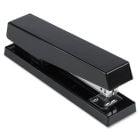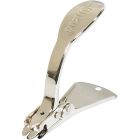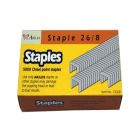Three Ways of Stapling With Dahle Novus Staplers
Did you know there are three different ways you can use a stapler? It may not seem like it, but based on the stapler you have, there are multiple ways it can be used depending on your needs. The three different ways of using a stapler are permanent fastening, temporary pinning, and tacking, and depending on which Dahle Novus stapler you have, you can either do two or three of these fastening types. To switch between methods, all you need to do is rotate the anvil on the base of the device, and have some knowledge of the three stapling methods. Here's some information about them.
1.) Permanent fastening. When you think of stapling, this is probably what comes to mind. Permanent fastening - also known as standard clinch - is what you need when you're confident you won't need to take apart your document at a later date. This type of stapling is often the last step in the production of business reports, personal correspondence, booklets, and more, and it can be done in both professional and casual environments. All Dahle Novus staplers - including the heavy-duty models - are capable of standard clinches since this is such a common method.
2.) Temporary pinning. If you've ever had to remove a staple from a document, you know how difficult it can be. No matter what kind of staple remover you use, wresting the fastener out of the paper can lead to frustration...not to mention a ruined document. Temporary pinning can help you avoid this situation because it allows you to easily remove staples from your papers. This method turns the legs of the staple out instead of in, giving the staple "wings," so to speak. This makes the fastener easy to remove with your bare fingers and without ripping your document. It's a great method to use not only when you think your document might need future editing, but when you want to avoid using paper and binder clips and other types of removable fasteners which can damage paper and get lost easily. This fastening method is available on Dahle Novus Executive, Flat Clinch, and Long-Arm products.
3.) Tacking. This stapling method is a little more common than temporary pinning and if you've ever attached stuff to a bulletin board, you may have used this method without even realizing it. Tacking occurs when you open your stapler and use it to literally staple a piece of paper to a wall, corkboard, or other vertical surface. This method is faster and easier on your fingers than using nails or pushpins to put stuff up, plus the staples are almost invisible so it looks great, too. Dahle Novus Executive and Flat Clinch staplers (except the B8FC) are the products to use when you want to tack and show off your documents.
As you can see, using a Dahle Novus stapler can really open up a new world of stapling thanks to their ability to permanently and temporarily fasten papers together, as well as attach them to an upright surface. No matter what type of fastening you need to do, it is possible with Dahle Novus products.









